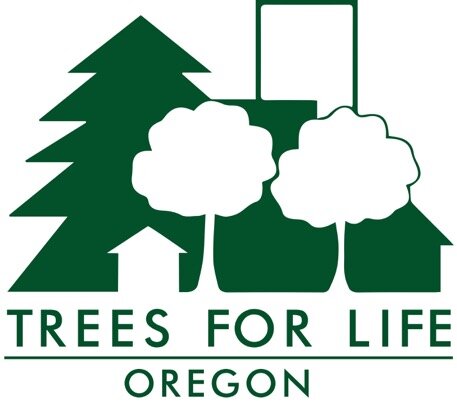PBOT and Urban Forestry Team Up to Pilot New Curb Bump-outs
An already existing PBOT/BES one-off installation on SE Hawthorne and 46th Avenue, designed without intent to replicate. Courtesy of PBOT.
Trees for Life Oregon has been arguing that the City can’t increase canopy in tree-deficient neighborhoods without preserving existing large-form trees and creating sufficient right-of-way space to plant new ones.
Some good news: The Portland Bureau of Transportation (PBOT) and Parks & Recreation’s Urban Forestry have recently received a $500,000 grant from the Bureau of Environmental Services (BES) to partner in a pilot project to test one means of creating new right-of-way space for big trees. (The BES funds come from a share of development charges used to support large green infrastructure projects.) The pilot will show how building curb bump-outs for street trees can expand canopy along streets now devoid of space for trees. The aim is to develop a policy framework for planting trees in the curb zone by expanding into the parking zone when other space for street trees is unavailable.
In the next two years the pilot will plant street trees in yet-to-be-determined corridors of East Portland, possibly in the Brentwood-Darlington neighborhood. That low-canopy area faces relatively high summer temperatures during heat waves. Another potential area is along SE Duke Street between SE 72nd and SE 92nd avenues.
Even potentially better news is this, per PBOT, “Once there is a proof of concept, it will be easier to implement in other parts of the city, by allowing PBOT to go after additional funding, as well as have clear design standards from city engineers for capital and development projects.”
This diagram is a conceptual, not an engineering drawing of trees in the curb zone, from the Pedestrian Design Guide. Courtesy of PBOT.
The project comes in the wake of the recent Pedestrian Design Guide update, which provides the option of curb bump-outs.
“One of the biggest things the project team heard from the public during the design guide process was the desire for innovative tree planting treatments,” according to PBOT. Portland residents who spoke out on the Pedestrian Design Guide take note—speaking up matters!
PBOT will offer to plant yard trees for neighbors living on the side of the street where underground and overhead utility lines and pipes conflict with street trees.
We applaud the fact that the pilot recognizes the potential space in people’s yards for large trees. We hope project leaders will also consider having Urban Forestry be responsible for maintaining those trees over time so that they thrive and live long enough to provide the health and ecological benefits they’re capable of delivering.
At her recent presentation about the project to the City’s Pedestrian Advisory Committee, project manager Gena Gastaldi presented this timeline for the pilot:
—September-December 2022: site selection, PBOT-BES- UF coordination
—January-August 2023: technical design refinement, outreach to communities in selected project area
—August-November 2023: tree well construction, continued community outreach
—November 2023-March 2024: tree planting
—March 2024-July 2024: project completion and wrap-up reporting
Read here for more information and see Gastaldi’s presentation here. If you have questions about the project, contact Gena Gastaldi at Gena.Gastaldi@portlandoregon.gov or 503-823-6142.


